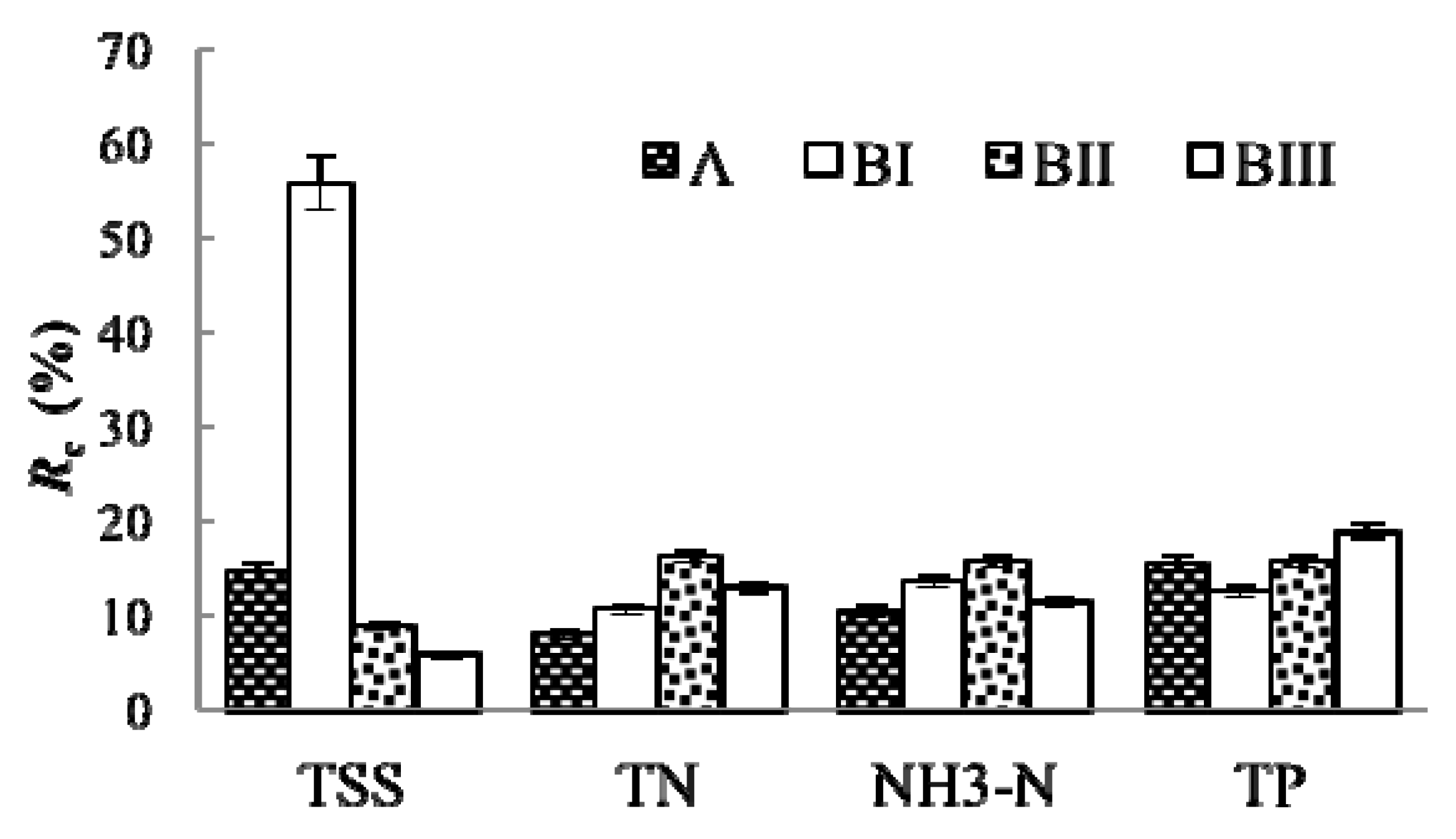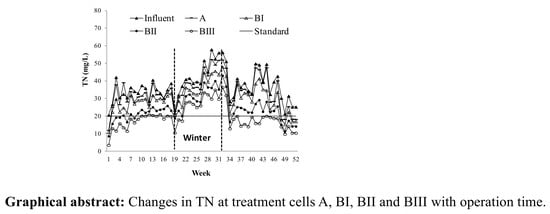A Constructed Wetland System for Rural Household Sewage Treatment in Subtropical Regions
Abstract
:1. Introduction
2. Materials and Methods
2.1. Basic Parameters Used for Treatment Process Design
2.2. Sequence of Treatment Cells Related to the Transformation Pathway
2.3. Plant Species and Substrates
2.4. Operation and Analysis
3. Results
3.1. Treatment Efficiency of the System
3.2. Effect of Pollutant Loading, Temperature and Sludge Discharge
3.3. Function and Contribution of Treatment Cells
4. Discussion
5. Conclusions
6. Patents
Author Contributions
Funding
Acknowledgments
Conflicts of Interest
References
- Reyes, C.P.D.L.; Villamar, C.A.; Neubauer, M.E.; Pozo, G.; Vidal, G. Behavior of Typha angustifolia L. in a free water surface constructed wetlands for the treatment of swine Wastewater. J. Environ. Sci. Health Part A 2013, 48, 1216–1224. [Google Scholar] [CrossRef] [PubMed]
- Shpigel, M.; Ben-Ezra, D.; Shauli, L.; Ventura, M.; Sagi, Y.; Samocha, T.; Lee, J.J. Constructed wetland with Salicornia as a biofilter for mariculture effluents. Aquaculture 2013, 412, 52–63. [Google Scholar] [CrossRef]
- Jesus, J.M.; Calheiros, C.S.C.; Castro, P.M.L.; Borges, M.T. Feasibility of Typha Latifolia for high salinity effluent treatment in constructed wetlands for integration in resource management systems. Int. J. Phytoremediat. 2014, 16, 334–346. [Google Scholar] [CrossRef] [PubMed]
- Troescha, S.; Salmaa, F.; Esser, D. Constructed wetlands for the treatment of raw wastewater: The French experience. Water Pract. Technol. 2014, 9, 430–439. [Google Scholar] [CrossRef]
- Wang, W.; Zheng, J.; Wang, Z.; Zhang, R.; Chen, Q.; Yu, X.; Yin, C. Performance of pond–wetland complexes as a preliminary processor of drinking water sources. J. Environ. Sci. 2016, 39, 119–133. [Google Scholar] [CrossRef] [PubMed] [Green Version]
- Brix, H.; Arias, C.A. Danish guidelines for small-scale constructed wetland systems for onsite treatment of domestic sewage. Water Sci. Technol. 2005, 51, 1–9. [Google Scholar] [CrossRef] [PubMed]
- Langergraber, G.; Weissenbacher, N. Survey on number and size distribution of treatment wetlands in Austria. Water Sci. Technol. 2017, 75, 2309–2315. [Google Scholar] [CrossRef] [PubMed]
- Solano, M.L.; Soriano, P.; Ciria, M.P. Constructed wetlands as a sustainable solution for wastewater treatment in small villages. Biosyst. Eng. 2004, 87, 109–118. [Google Scholar] [CrossRef]
- Wu, S.; Austin, D.; Liu, L.; Dong, R. Performance of integrated household constructed wetland for domestic wastewater treatment in rural areas. Ecol. Eng. 2011, 37, 948–954. [Google Scholar] [CrossRef]
- Sun, H.; Zhang, H.; Yu, Z.; Wu, J.; Jiang, P.; Yuan, X.; Shi, W.M. Combination system of full-scale constructed wetlands and wetland paddy fields to remove nitrogen and phosphorus from rural unregulated non-point sources. Environ. Geochem. Health 2013, 35, 801–809. [Google Scholar] [CrossRef] [PubMed]
- Lopez-Rivera, A.; Lopez-Lopez, A.; Vallejo-Rodrıguez, R.; Leon-Becerril, E. Effect of the organic loading rate in the stillage treatment in a constructed wetland with canna indica. Environ. Progress Sustain. Energy 2015, 35, 411–415. [Google Scholar] [CrossRef]
- Shelef, O.; Gross, A.; Rachmilevitch, S. Role of plants in a constructed wetland: Current and new perspectives. Water 2013, 5, 405–419. [Google Scholar] [CrossRef]
- Wang, H.; Chen, Z.; Zhang, X.; Zhu, S.; Ge, Y.; Chang, S.X.; Zhang, C.B.; Huang, C.C.; Chang, J. Plant species richness increased belowground plant biomass and substrate nitrogen removal in a constructed wetland. Clean Soil Air Water 2013, 41, 657–664. [Google Scholar] [CrossRef]
- Lombard Latune, R.; Laporte-Daube, O.; Fina, N.; Peyrat, S.; Pelus, L.; Molle, P. Which plants are needed for a French vertical-flow constructed wetland under a tropical climate? Water Sci. Technol. 2017, 8, 1873–1881. [Google Scholar] [CrossRef] [PubMed]
- Chyan, J.M.; Senoro, D.B.; Lin, C.J.; Chen, P.J.; Chen, I.M. A novel biofilm carrier for pollutant removal in a constructed wetland based on waste rubber tire chips. Int. Biodeterior. Biodegrad. 2013, 85, 638–645. [Google Scholar] [CrossRef]
- Cui, L.J.; Li, W.; Zhou, J.; Zhang, Y.; Zhang, M.Y.; Lei, Y.R.; Kang, X.M.; Zhao, X.S.; Pan, X. Influence of substrate depth and particle size on phosphorus removal in a surface flow constructed wetland. Water Sci. Technol. 2017, 75, 2291–2298. [Google Scholar]
- Cui, L.; Ouyang, Y.; Gu, W.; Yang, W.; Xu, Q. Evaluation of nutrient removal efficiency and microbial enzyme activity in a baffled subsurface-flow constructed wetland system. Bioresour. Technol. 2013, 146, 656–662. [Google Scholar] [CrossRef] [PubMed]
- Meng, P.; Pei, H.Y.; Hu, W.; Shao, Y.; Li, Z. Performance evaluation of light-weight aggregates-based horizontal flow constructed wetlands for domestic wastewater treatment. Clean Soil Air Water 2015, 43, 217–222. [Google Scholar] [CrossRef]
- Wynn, T.M.; Liehr, S.K. Development of a constructed subsurface-flow wetland simulation model. Ecol. Eng. 2001, 16, 519–536. [Google Scholar] [CrossRef]
- Rousseaua, D.P.L.; Vanrolleghemb, P.A.; De Pauw, N. Model-based design of horizontal subsurface flow constructed treatment wetlands: A review. Water Res. 2004, 38, 1484–1493. [Google Scholar] [CrossRef] [PubMed]
- Meyer, D.; Chazarenc, F. Modelling constructed wetlands: Scopes and aims- a comparative review. Ecol. Eng. 2015, 80, 205–213. [Google Scholar] [CrossRef]
- Langergraber, G. Applying Process-Based Models for Subsurface Flow Treatment Wetlands: Recent Developments and Challenges. Water 2017, 9, 5. [Google Scholar] [CrossRef]
- Vymazal, J. The use of hybrid constructed wetlands for wastewater treatment with special attention to nitrogen removal: A review of a recent development. Water Res. 2013, 47, 4795–4811. [Google Scholar] [CrossRef] [PubMed]
- Wu, S.; Kuschk, P.; Wiessner, A.; Müller, J.; Saad, R.A.B.; Dong, R. Sulphur transformations in constructed wetlands for wastewater treatment: A review. Ecol. Eng. 2013, 2, 278–289. [Google Scholar] [CrossRef]
- Abbassi, B.; Al-Zboon, K.; Radaideh, J.; Wahbeh, A. Using constructed wetlands to improve drainage water quality from hydroponics farms. Irrig. Drain. 2011, 60, 370–380. [Google Scholar] [CrossRef]
- Shao, Y.; Pei, H.; Hu, W. Nitrogen removal by bioaugmentation in constructed wetlands forrural domestic wastewater in autumn. Desalin. Water Treat. 2013, 51, 6624–6631. [Google Scholar] [CrossRef]
- EPA, National Risk Management Research Laboratory Office of Research and Development U.S. Manual Constructed Wetlands Treatment of Municipal Wastewaters; Environmental Protection Agency: Cincinnati, OH, USA, 2000; p. 79.
- Yang, Q.; Chen, Z.; Zhao, J.; Gu, B. Contaminant removal of domestic wastewater by constructed wetlands: Effects of plant species. J. Integr. Plant Biol. 2007, 49, 437–446. [Google Scholar] [CrossRef]
- Dzakpasu, M.; Scholz, M.; MCIWEM; McCarthy, V.; Jordan, S. Phosphorus retention and mass balance in an integrated constructed wetland treating domestic wastewater. Water Environ. J. 2015, 29, 298–306. [Google Scholar] [CrossRef]



| Cell | Type | Major Target Pollutant | Main Reaction | Plant Species | Substrate |
|---|---|---|---|---|---|
| A | Surface flow | Organic pollutant Suspended solid | Sedimentation Precipitation Decomposition Uptake | Hydrocotyle vulgaris Ipomoea aquatica Forsk. Otnanthe Ljavanica (Blume) DC. Hydrilla verticillata Myriophyllum verticillatum | none |
| BI | Subsurface flow | Organic pollutant Suspended solid | Decomposition Filtration Uptake Adsorption | Hibiscus mutabilis Linn. Metasequoia glyptostroboides Rosa chinensis Jacq. Pontederia cordata Brassica campestris L. Iris germanica L. | 1: Limestone (Φ1 cm–Φ2 cm) 2: Diatomite 3: Vermiculate 4: Limestone (Φ3 cm–Φ5 cm) |
| BII | Subsurface flow | Organic pollutant Cationic pollutant | Decomposition Uptake Adsorption | Salix babylonica Loropetalum chinense var.rubrum Nerium indicum Mill. Acorus calamus L. Typha orientalis Presl. Oenanthe javanica (Blume) DC. | 1: Limestone (Φ1 cm–Φ2 cm) 2: Zeolite 3: Limestone (Φ3 cm–Φ5 cm) |
| BIII | Subsurface flow | Organic pollutant Anionic pollutant | Decomposition Uptake Adsorption | Fargesia fungosa Yi Arundo donax var. versicolor Thalia dealbata Link | 1: Limestone (Φ1 cm–Φ2 cm) 2: Hydrotalcite 3: Limestone (Φ3 cm–Φ5 cm) |
| Index | TSS | CODCr | BOD5 | TN | NH3-N | TP |
|---|---|---|---|---|---|---|
| Influent (mg/L) | 55~80 | 79.5~322.6 | 46.7~121.9 | 20.3~57.9 | 17.1~55.5 | 1.79~6.83 |
| Standard * (mg/L) | 20 | 60 | 20 | 20 | 8 | 1 |
| RM (%) | 75 | 82 | 84 | 66 | 86 | 86 |
| Index | TSS | ☐ | CODCr | ☐ | BOD5 | ☐ | TN | ☐ | NH3-N | ☐ | TP | ☐ |
|---|---|---|---|---|---|---|---|---|---|---|---|---|
| Cell | Cef | Ra | Cef | Ra | Cef | Ra | Cef | Ra | Cef | Ra | Cef | Ra |
| O | 68.0 ± 4.0 | 0.0 | 172.5 ± 9.8 | 0.0 | 88.8 ± 5.4 | 0.0 | 38.3 ± 1.9 | 0.0 | 36.4 ± 2.0 | 0.0 | 3.92 ± 0.24 | 0.0 |
| A | 58.0 ± 2.0 | 14.7 ± 0.5 | 123.9 ± 5.7 | 28.2 ± 1.2 | 73.8 ± 4.1 | 16.9 ± 1.0 | 35.3 ± 2.1 | 7.9 ± 0.4 | 32.6 ± 1.9 | 10.4 ± 0.6 | 3.32 ± 0.20 | 15.2 ± 0.9 |
| BI | 20.0 ± 1.0 | 70.6 ± 2.7 | 85.6 ± 3.9 | 50.4 ± 2.6 | 40.5 ± 2.3 | 54.4 ± 3.1 | 31.2 ± 1.9 | 18.5 ± 1.1 | 27.7 ± 1.6 | 23.9 ± 1.4 | 2.84 ± 0.17 | 27.5 ± 1.6 |
| BII | 14.0 ± 0.5 | 79.4 ± 3.0 | 56.0 ± 2.4 | 67.5 ± 3.2 | 30.1 ± 1.5 | 66.1 ± 3.5 | 25.1 ± 1.5 | 34.6 ± 1.9 | 22.0 ± 1.3 | 39.6 ± 2.1 | 2.23 ± 0.13 | 43.1 ± 2.4 |
| BIII | 10.0 ± 0.3 | 85.3 ± 3.4 | 30.4 ± 1.6 | 82.4 ± 4.0 | 17.7 ± 0.9 | 80.1 ± 4.2 | 20.1 ± 1.2 | 47.5 ± 2.8 | 17.8 ± 1.0 | 51.0 ± 2.7 | 1.50 ± 0.08 | 61.8 ± 3.6 |
| GB * | 1st | ☐ | 1st | ☐ | 1st | ☐ | 2nd | ☐ | 2nd | ☐ | 2nd | ☐ |
| Cell | TSS | CODCr | TN | NH3-N | TP |
|---|---|---|---|---|---|
| A | 0.88 | 0.90 | 0.96 | 0.97 | 0.88 |
| BI | 0.72 | 0.79 | 0.94 | 0.91 | 0.58 |
| BII | 0.38 | 0.70 | 0.88 | 0.85 | 0.46 |
| BIII | 0.21 | 0.69 | 0.77 | 0.79 | 0.38 |
| Unit | TSS | CODCr | TN | NH4+-N | TP |
|---|---|---|---|---|---|
| A | 14.7 ± 0.8 | 28.2 ± 1.6 | 7.9 ± 0.4 | 10.4 ± 0.5 | 15.2 ± 0.6 |
| BI | 65.5 ± 3.7 | 30.9 ± 1.5 | 11.5 ± 0.5 | 15.1 ± 0.8 | 14.5 ± 0.5 |
| BII | 30.0 ± 1.8 | 34.5 ± 1.6 | 19.8 ± 1.0 | 20.6 ± 0.9 | 21.5 ± 0.9 |
| BIII | 28.6 ± 1.6 | 45.7 ± 2.2 | 19.7 ± 1.1 | 18.9 ± 0.7 | 32.8 ± 1.3 |
© 2018 by the authors. Licensee MDPI, Basel, Switzerland. This article is an open access article distributed under the terms and conditions of the Creative Commons Attribution (CC BY) license (http://creativecommons.org/licenses/by/4.0/).
Share and Cite
Fu, X.; Wu, X.; Zhou, S.; Chen, Y.; Chen, M.; Chen, R. A Constructed Wetland System for Rural Household Sewage Treatment in Subtropical Regions. Water 2018, 10, 716. https://doi.org/10.3390/w10060716
Fu X, Wu X, Zhou S, Chen Y, Chen M, Chen R. A Constructed Wetland System for Rural Household Sewage Treatment in Subtropical Regions. Water. 2018; 10(6):716. https://doi.org/10.3390/w10060716
Chicago/Turabian StyleFu, Xinxi, Xiaofu Wu, Sangyang Zhou, Yonghua Chen, Mingli Chen, and Runhua Chen. 2018. "A Constructed Wetland System for Rural Household Sewage Treatment in Subtropical Regions" Water 10, no. 6: 716. https://doi.org/10.3390/w10060716
APA StyleFu, X., Wu, X., Zhou, S., Chen, Y., Chen, M., & Chen, R. (2018). A Constructed Wetland System for Rural Household Sewage Treatment in Subtropical Regions. Water, 10(6), 716. https://doi.org/10.3390/w10060716





